 |
 |
 Aeneas and Venus, Tiepolo 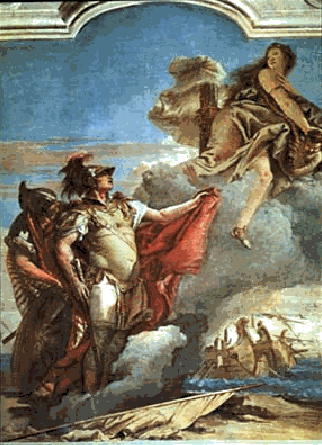 Tiepolo senior and junior (1757), Aeneas and Venus, villa Valmarana, Vicenza, Aen. 1,310ss. Villa Valmarana 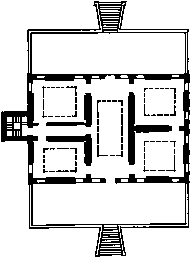 This country house consists of various buildings: the real villa, the guest-rooms and the stable. The oldest structure is the villa already existing in 1669. A scholar of Vicenza, Gian Maria Bertolo, ordered its design to an unknown architect. Then, in the early eighteenth century the villa was purchased by the earls of Valmarana who still are its owners. Valmarana earls wanted to erect new buildings: the stable and the guest-rooms with its arcade. Also the name of the architect designing these new structures is not surely known: according to some hypotheses he could be Francesco Muttoni or Giorgio Massari. In 1757 the earl Giustino di Valmarana ordered Giambattista Tiepolo to fresco the interiors of the villa. Giambattista left free hand to his son Giandomenico who proposed a cycle of his own frescoes. This is important because only in this villa the works of these two artists can be compared and particularly the worth of Domenico, too often shaded by his father's light, can be appreciated. The villa The first room is the "Portego" (arcade). For Venetians this structure allows the outside to communicate with the interior. Tiepolo immediately allures the visitors with his first paintings: Iphigenia's destiny. On the other wall, there are some soldiers in foreground, whereas the masts of the Greek ships unable to sail for lack of wind can be seen in the background. Above the side doors, there are the personifications of the four longest rivers of the world. The theme of the second room is the Iliad and particularly the bond linking the hero Achilles and his slave girl Briseis. The following room shows a compendium of Ariosto's masterpiece, the "Orlando Furioso". Aeneid by Virgil, or better Dido Deserted is the theme of the fourth room. Once landed at the African coast after a storm, Aeneas thanks his own mother Venus appearing to him. The hero looks like a singer starting an aria: in fact he is represented with an arm lifted, the mouth half-open and the bosom full of air. Dido sitting on her throne is splendid and Aeneas introduces his son Ascanius, but Cupid hides himself under the boy's features. 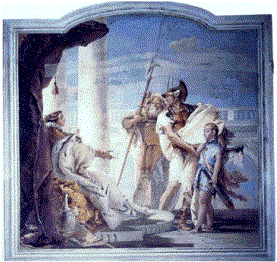 Tiepolo padre e figlio (1757), Enea presenta Cupido nelle vesti di Ascanio a Didone - villa Valmarana, Vicenza, Aen. 1,715 ss. Aeneas does not know how to do: to stay or to leave. The moment of his reflection is represented on the third wall. The symbols of his duty are on the ground while Mercury is coming. 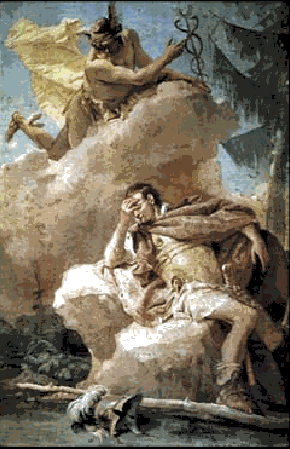 Tiepolo padre e figlio (1757), Mercurio esorta Enea alla partenza - villa Valmarana, vicenza, Aen. 4,238-278, in part. 270 ss. Above the mirrors, the forge of the God Vulcan can be admired. The last room is dedicated to the poem "Jerusalem Delivered" by Torquato Tasso. 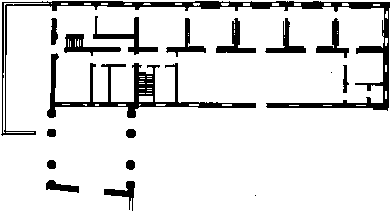 Foresteria Villa Valmarana The frescoes decorating the guest-rooms, excepting those of the central hall, were painted by Giandomenico Tiepolo. The first room is dedicated to the Chinese world. Giandomenico did not visit the Celestial Empire, he had heard something of it, probably he read the several travel reports published in his century. So he thought that it was a wonderful country where very odd animals and very big insects lived and unthinkable vegetables grew. The second room shows some scenes of everyday life of Venetian peasants. Noblemen are the protagonists of the third room, also called "Gothic" for its architectural decorations. The central hall frescoed by the father Giambattista shows the Olympus of Gods. The dining room, or room of the Carnival, shows a Moor coming down the stairs to serve some chocolate: according to the critics this figure was painted by Giambattista. The "room of the loggia" was frescoed by Antonio Visentini: gardens and villas crowded by small personages occupy the spaces between the columns. The last room is dedicated to the "putti": some putti are playing with each other. The age of Tiepolo For the Serene Republic of St. Mark the eighteenth century was a period of great cultural and artistic growth. On the contrary the commercial supremacy and economical weight that Venice held in Europe in the previous centuries had been already lost. Being probably aware of this crisis and slow decay, Venetian noblemen spent a good deal of their strength extolling magnificence and greatness through the arts. In fact, the highest periods of artistic history of peoples and nations often occur in the phase of their decline. The artist representing this splendour was Giambattista Tiepolo: he was able to summarize centuries of Venetian painting and his art had a great success all over Europe. Giambattista Tiepolo (Venice, 1696 - Madrid, 1770), called "Tiepoletto", was apprenticed to Lazzarini's atelier at Venice. But the education of the young painter was also influenced by other exponents of Venetian pictorial art: from Paolo Caliari to Sebastiano Ricci. In those years Venice was celebrated all over Europe as a great centre of culture and theatrical production. It was one of the few capital cities offering its inhabitants dramas and operas almost in any period of the year. On the Lagoon several permanent companies could live by their daily work preparing performances. Giambattista was enchanted by this world, particularly by the genre of opera and the figures of his frescoes ideally represent the actors seen on the main stages. 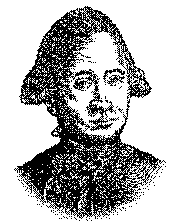  |








